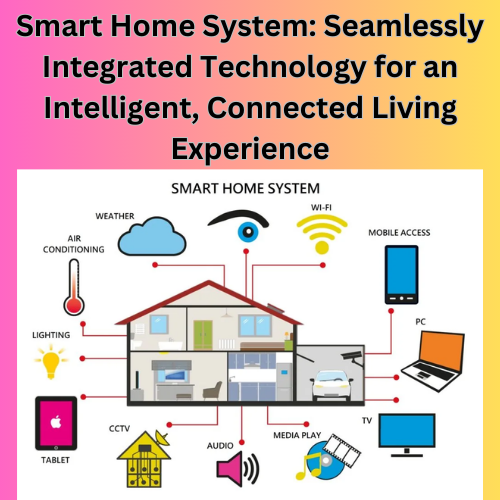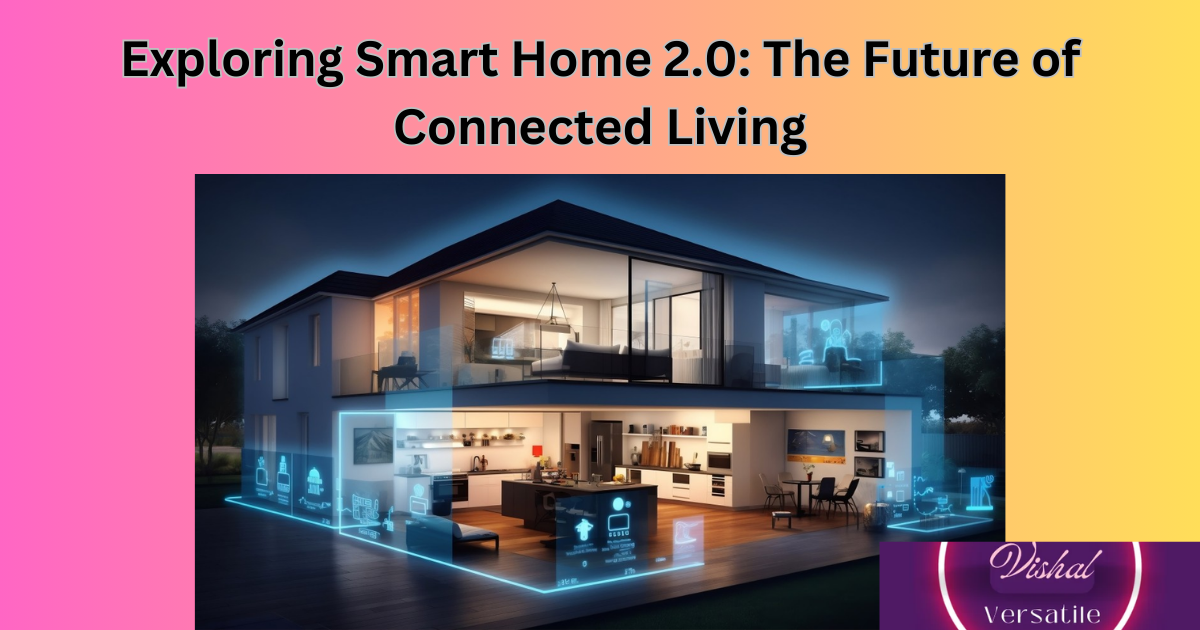In the rapidly evolving landscape of technology, the concept of smart homes has taken center stage, and it’s not slowing down. Welcome to the era of Smart Homes 2.0, where living spaces are not just connected but intelligently responsive, creating an unprecedented level of comfort, convenience, and sustainability.
Smart Homes 2.0: Future Ready living Spaces Unveiled, displays new technological development in the field of home automation with increased automation, efficiency in energy usage, and even smoother connectivity. These smart homes of the future are bound to integrate the latest gadgets and systems for living more intuitively, safely, and environmentally conscious.
| FEATURE | DESCRIPTION | |
|---|---|---|
 Image by - FREEPIK, 'All in one smart home control system app concept on tablet display in man hands' | Automation | Mere swiping devices or tapping apps bring about seamless lighting, temperature, and security. |
| Energy Efficiency | Integrating smart thermostats, solar panels, and energy management systems to reduce consumption. | |
 | Connectivity | Advanced IoT integration for real-time data sharing and control across devices. |
| Security | Smart locks, cameras, and AI-driven monitoring and surveillance in place for property protection enhance it. | |
| Sustainability | Utilization of eco-friendly materials and systems created for low environmental impact. |

Embracing the Future: What is Smart Homes 2.0?
Smart Homes 2.0 represent the next phase in the evolution of home automation. Smart locks, cameras, and AI-driven monitoring and surveillance in place for property protection enhance it. Imagine a home that anticipates your needs, responds to your commands, and optimizes energy usage—all while providing unparalleled security.
जादू का अनावरण: How Does a Smart Home Work?
Poem on Smart Homes 2.0 in Hindi
आओ चलें, स्मार्ट होम्स 2.0 की दुनिया में,
जहां घर के दरवाज़े खुद खोलते हैं।
स्विच नहीं, बल्कि आवाज़ से,
जैसे गीतों की स्वरमंडल में गाते हैं।
बिजली की लहरों में तैरते हैं उपकरण,
जैसे तारों की छाया से भरी रातें।
जब बिना हाथ लगाए हम बल्ब,
स्मार्ट होम्स 2.0 की ताकद में आते हैं।
अपने आप समझते हैं वो ज़रूरतें,
जैसे जीवन की नई रफ्तार से बढ़ते हैं।
जैसे विश्वास करते हैं वो आपकी आवाज़ पर,
स्मार्ट होम्स 2.0 की दुनिया में जीते हैं।
Key Features Reshaping the Smart Homes Landscape
Artificial Intelligence (AI) Integration:
Smart Homes 2.0 leverage AI to understand and adapt to your lifestyle. From learning your preferred room temperature to adjusting lighting based on your daily routines, AI turns these spaces into intelligent companions.
- Imagine you wake up in the morning. The smart home system detects your movement and learns that you prefer a warm room temperature. It adjusts the thermostat accordingly, ensuring comfort without manual intervention.
- With thermostat the detection of the required temperature becomes easy. As per your movement from the bed, it learns and adjusts the room temperature as per the body’s requirement. The thermostat consists of a temperature sensor that senses the room temperature and when the temperature deviates from the desired set point, if its too cold the thermostat activates the furnace or the heating pump. if its too cold it triggers the air conditioner. it continuously monitors the temperature and adjusts the heating or cooling output to maintain the desired level. It might also consider factors like sunlight exposure, time of day and occupancy.
- As evening approaches, the system dims the lights in the living room, creating a cozy ambiance for relaxation. If you’re reading, it optimizes the lighting for better visibility. The light adjusts itself to automatically to brighten or darken to dim as per the need.
- When you enter the kitchen, the smart home system starts playing your favorite upbeat tunes to energize your morning routine.
- The system notices you’re working late and adjusts the lighting to reduce eye strain. It also reminds you to take breaks for better productivity.

Internet of Things (IoT) Ecosystems:
The IoT is the backbone of Smart Homes 2.0. Connect your appliances, security systems, and even your coffee maker to a centralized network, allowing seamless communication and control through your smartphone or voice commands.
Imagine you have a smart coffee maker connected to your home network. Here’s how it works:
- When you wake up in the morning, the coffee maker senses your movement and starts preparing fresh cup of coffee. There is no need to manually press any buttons. You can ask your Alexa or Google assistant to prepare your coffee. If the coffee beans are running low you can reorder them in a single tap on your smart phone.
- The Coffee maker senses your movement and when you are leaving home, it automatically switches to the standby mode, without having to switch it off manually to conserve energy.

Energy Efficiency and Sustainability:
Future-ready living spaces prioritize sustainability. Smart Homes 2.0 come equipped with energy-efficient appliances, smart thermostats, and solar energy integration, contributing to a greener and more eco-friendly environment.
- Suppose you have a smart refrigerator which is to be used. Now according to the available ingredients it will suggest you recipes which can be prepared accordingly.
- According to the ingredients available in the refrigerators it adjusts its cooling based on their usage pattern. For example, in summer Milk can get split easily because of hot weather. So it adjusts the temperature to cool the milk during the afternoon.
- Because of these automatic adjustments of cooling and heating energy is saved which reduces electricity bill and also reduces waste products in our kitchen refrigerators. The smart thermostats understands your daily routine. It adjusts heating or cooling based on outdoor temperature. You can control the thermostat remotely via smart phone. The luxurious comforts of remote adjustments makes our living easy.
- Installing solar panels on our roofs help you harness sunlight and convert it into electricity. Solar installation is recommended because it is cost efficient. It helps relying less on fossil fuels and excess energy that is produced by solar panels can be stored in batteries and fed back into grid.
- The energy and cost efficient solar panels reduce the green house gas emissions and use renewable energy resources. The energy can be used and sustained for a longer period of time and one where future generations can thrive.
- Suppose you arrive home and you have activated the face recognition technology for your identity, the system equipped with smart cameras, recognize your face and automatically unlocks the door.
- They consists of multiple access modes like keypad, smartphone app, voice command. When the guests arrive at your homes, you being not present at your homes, they can access the system to unlock the door and use it.
- Smart cameras installed at the doors provide live video feeds accessible via your phone or tablet. If anyone is at your door during working hours, a message is provided at your smart phone about his/ her presence at the door.
- This helps you know that someone is at the door of your house and ensures your peace of mind.
Advanced Security Systems:
Safety is paramount in Smart Homes 2.0. Enjoy features like facial recognition, smart locks, and real-time surveillance, enhancing the security of your living space.
- Suppose you’re on vacation, and your smart home system detects motion near your back door. You receive an instant alert on your phone. You open the app and see a live video feed—someone is attempting to enter. You remotely activate the alarm or notify authorities. Thanks to these features, your home remains secure even when you’re miles away!
Voice and Gesture Controls:
Interact with your home using intuitive voice commands or gestures. Smart Homes 2.0 are breaking barriers, making technology accessible and user-friendly for all generations.
- You host a family party, and your elderly grandparents come. They are not people of modern gadgets, but your Smart Home 2.0 treats them just fine. Your grandma says, “Alexa, play soothing music,” and the room fills with her favorite tunes. Your grandpa gestures for the blinds to lower for privacy but touches nothing. Technology empowers them; its user-friendliness impresses you.
The Impact on Daily Life
The integration of Smart Homes 2.0 into daily routines brings about a paradigm shift. Imagine waking up to a house that senses your awakening and adjusts the ambiance to gently rouse you. As you leave for work, your home ensures all appliances are turned off, and the security system is armed. Return to a perfectly lit and climate-controlled environment, tailored to your preferences.
How do smart home appliances work
- How do smart home appliances work is a question everyone is asking, especially after COVID-19 pandemic.
- A smart home has number of appliances which work on IoT (Internet of Things) through mobile phone apps.
- Your mobile phone consists of an app which has access to the appliances of the smart phones through the internet.
- Press the relevant buttons in the app to use the smartphone apps.
- In the smartphone IoT devices are connected via the internet and a mobile app can access them.
- Smart Thermostats, refrigerators, door-bells, home security sensors can be managed and used through mobile apps.
- Smart Homes offer great facilities for people working from home, improving living spaces and adopting new lifestyles.

The Road Ahead: Challenges and Opportunities
While the future looks promising, challenges such as data security and standardization remain. As Smart Homes 2.0 become more prevalent, industry players must address these concerns to ensure widespread adoption.
In conclusion, Smart Homes 2.0 represent a quantum leap in home automation, promising an unprecedented level of integration, efficiency, and personalization. As we embrace this future-ready living concept, it’s clear that our homes are no longer just spaces; they are intelligent ecosystems designed to enhance and simplify our lives. Get ready to embark on a journey where the phrase “home sweet home” takes on a whole new meaning. Welcome to the future of living—Smart Homes 2.0.
The reference of the above article is from, MDPI (2023). “Smart Adaptive Homes and Their Potential to Improve Space Efficiency.” Journal of Smart Environments, 13(5), 1132.
Can a Smart Home 2.0 save energy?
Yes, energy-saving is a significant feature of Smart Home 2.0. Devices like smart thermostats, energy-efficient lighting, and real-time monitoring systems help reduce electricity usage and lower utility bills.
Is Smart Home 2.0 secure?
Security in Smart Home 2.0 is enhanced through biometric locks, encrypted networks, and AI-driven monitoring. However, users should regularly update firmware and use strong passwords to prevent cyber threats.

